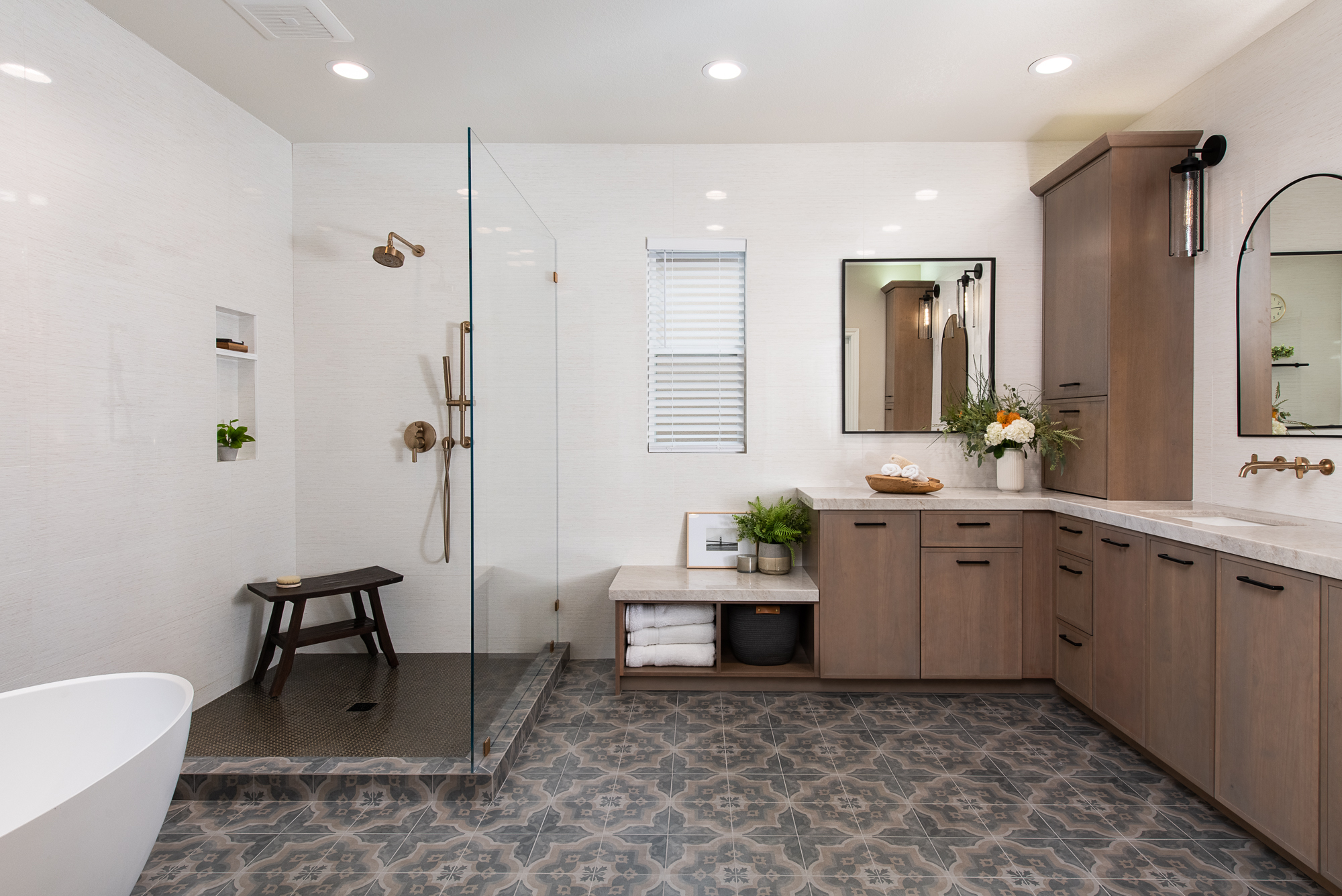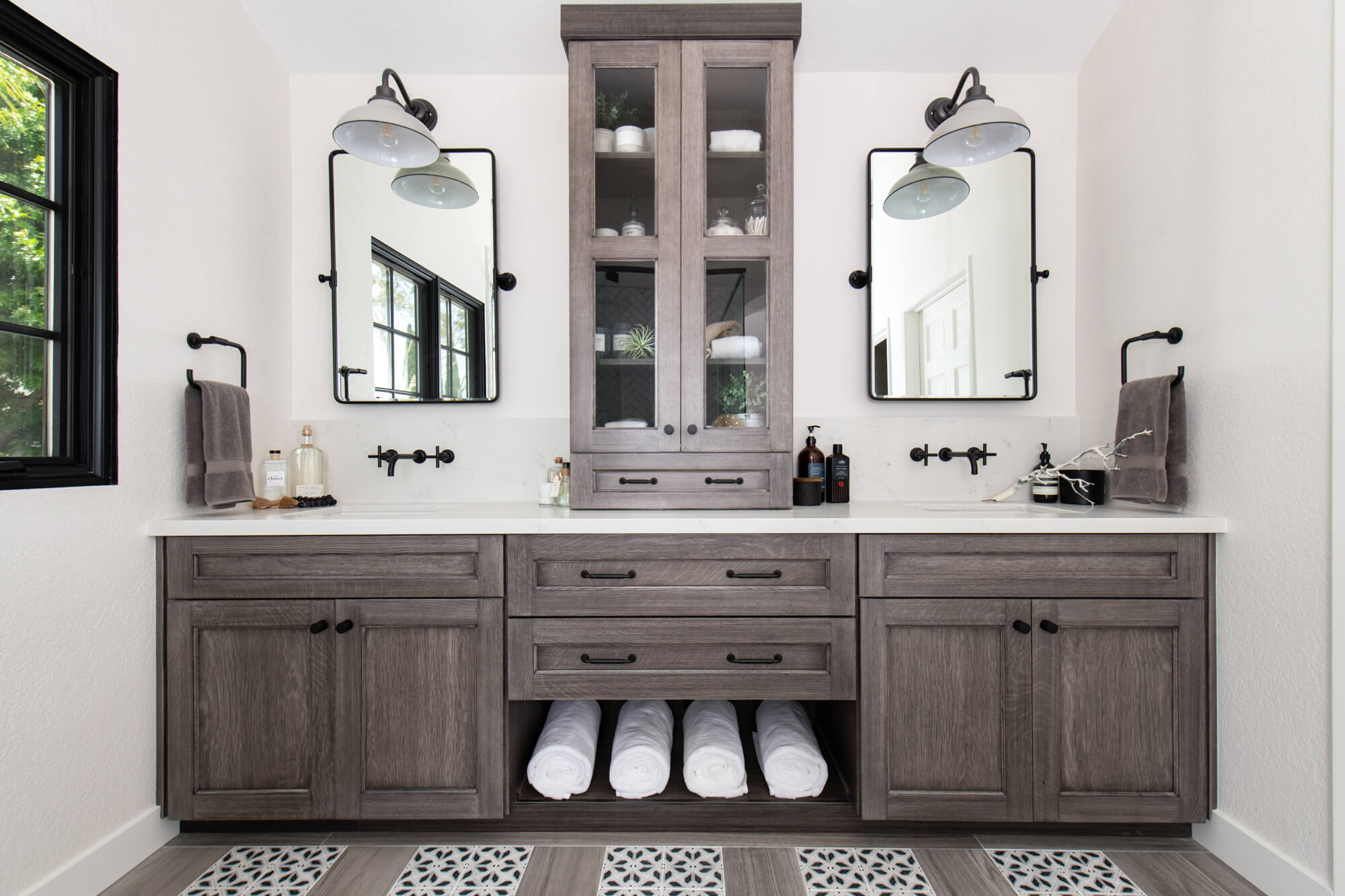Japandi Bathroom Design | Orange County
Japandi bathroom design is a unique style that blends the best of Japanese and Scandinavian elements. In Orange County, the trend for Japandi bathrooms is growing, as more homeowners seek a simple, yet elegant upgrade to their spaces.

As a renowned local design and remodel firm, Sea Pointe excels in creating these serene retreats, focusing on minimalism and functionality that reflect the core principles of Japandi aesthetics.
At Sea Pointe, we understand that the beauty of Japandi bathroom design lies in its ability to fuse two distinct styles: the clean lines and functionality of Scandinavian design with the natural elements and comfort of Japanese style.
This approach results in a tranquil space that promotes relaxation and peace. Our team is dedicated to designing bathrooms that are beautiful and also practical, ensuring that every element works in harmony to meet the needs of our clients.
Throughout this page, we will explore various aspects of Japandi bathroom design in Orange County. We will discuss how to select the right materials and colors to achieve a balanced look, and how to layout the space efficiently.
Our designers will share tips on choosing fixtures and features that fit the Japandi style, from sleek bathtubs to minimalist sinks and taps. You will also get insights into the latest trends and how to adapt them to your bathroom.
By the end, you will have a clearer understanding of how Japandi bathroom design can transform your home into a haven of calm and sophistication. Stay tuned to see how you can bring this elegant yet simple style into your bathroom.
Understanding Japandi Bathroom Design
Japandi bathroom design cleverly combines the rustic elegance of Japanese aesthetics with the functional minimalism of Scandinavian style. This fusion creates a serene and timeless look, perfect for modern homes. At its core, the Japandi style emphasizes simplicity, natural elements, and a muted color palette, promoting a sense of tranquility and cleanliness.
Key features of Japandi bathroom designs include the use of natural wood, soft neutral colors, and plenty of texture to add warmth without clutter. For instance, pale oak cabinets and stone sinks can merge seamlessly with soft, white towels and matte black fixtures, creating a harmonious balance between cozy and sleek elements.

In terms of functionality, every piece in a Japandi bathroom has a purpose. There are no superfluous decorations; each item adds to the aesthetic and also serves a practical function. This could mean integrated storage solutions that hide away toiletries or multi-functional furniture that maximizes space.
This design aesthetic also leans heavily on the concept of ‘wabi-sabi’, the beauty of imperfection. Handmade ceramic accessories and irregular stone tiles can be used to introduce an element of organic imperfection, which makes the space feel more personal and lived-in.
By embracing these principles, Japandi bathrooms in Orange County are not just visually appealing but also spaces of comfort and practicality, where every element works in harmony to create a peaceful retreat from the bustling world outside.
The Japandi Bathroom Aesthetic: Combining Elements
Creating the perfect Japandi bathroom involves a delicate balance between contrasting elements. The challenge is to blend the warm, nature-inspired tones of Japanese design with the cool, clean lines of Scandinavian minimalism. It is essential to create a minimalist look without feeling too stark, and with a warm, inviting atmosphere.
Start with a color palette that uses neutral earth tones such as soft grays, browns, and creams are ideal. These colors can serve as a soothing backdrop that ties the different design elements together.

For materials, think natural and unfinished-looking: woods like cedar or pine, stone, and matte-finished metals. These materials help create a tactile experience that emphasizes natural beauty.
Furniture and fixtures in a Japandi bathroom should combine functionality with a simple aesthetic. Consider a sleek, freestanding tub paired with a wooden stool or a bamboo ladder for towels. The fixtures might include streamlined taps and showerheads in brushed nickel or matte black, emphasizing clean lines and usability.

For the layout, spatial organization should focus on flow and openness. Avoid clutter at all costs; instead, opt for built-in shelving or hidden cabinets for storage. This maximizes space and also keeps the lines of the room clean, which is essential in Japandi design.
Incorporating greenery, such as small potted plants or a vertical garden, can add a splash of color and life to the bathroom. This complements the natural materials used in Japandi interiors and also enhances the tranquil, airy feel of the space. You can create a Japandi bathroom that is both beautifully minimalist and warmly inviting by thoughtfully combining these elements.
Practical Tips for Designing Your Japandi Bathroom
When designing a Japandi bathroom, the focus should always be on creating a space that embodies harmony and minimalism. Here are some practical tips to help achieve this aesthetic in your Orange County home:
Firstly, consider the layout of the room. Japandi spaces are well-planned and uncluttered. Opt for a layout that feels open and airy. This can be accomplished by choosing wall-mounted or floating fixtures like sinks and toilets, which help to maximize floor space and enhance the minimalist look.

Choose your materials wisely. Natural materials such as wood, stone, and linen play crucial roles in Japandi design. For instance, wooden vanity units or stone countertops can add a touch of natural beauty without overwhelming the space. It’s important to treat and seal these materials properly to withstand the damp bathroom environment.
Lighting is another critical factor. Opt for indirect lighting that casts a soft glow rather than harsh overhead lights. Consider installing dimmer switches to easily adjust the mood of the room. For task lighting, sleek, modern fixtures that echo the minimalist theme are perfect.

Accessorizing a Japandi bathroom should be done sparingly. Choose a few key pieces, such as a framed mirror with a simple wooden frame or hand-thrown ceramic vessels for a touch of artisan craftsmanship. These elements should serve a functional purpose and also contribute to the overall aesthetic.
Finally, consider the sensory experience. A Japandi bathroom should look beautiful and also feel serene. Incorporate elements like a softly trickling water feature or a diffuser with cedar or sandalwood oil to elevate the tranquility of the space.
With these tips, you can create a Japandi bathroom that is a visual delight and also a peaceful retreat in your home.
Japandi Bathroom Features and Fixtures
Selecting the right features and fixtures is crucial to achieving the authentic Japandi look in your bathroom. This involves choosing items that reflect the minimalist aesthetic and are also highly functional.
Here are detailed guidelines to help you choose the best fixtures for your Japandi bathroom design in Orange County:
Sinks and Faucets

Opt for under-mounted or vessel sinks made from natural materials like stone or ceramic. These should have simple, clean lines with no ornate detailing. Faucets should be sleek and modern, with matte finishes in black or brushed nickel to complement the other elements of the room seamlessly.
Bathtubs

A freestanding tub with a simple, sculptural form can serve as a focal point in a Japandi bathroom. Look for tubs in matte white or stone finishes. The key is to keep the shape organic but minimalistic, avoiding any intricate details or embellishments.
Showers

Walk-in showers are ideal, with frameless glass to maintain an open and airy feel. Use large, matte tiles in neutral colors for the walls and floor. Consider incorporating a wooden bath mat or a small wooden bench inside the shower area to bring in warmth and tie back to the natural elements typical of Japandi style.
Storage Solutions
Japandi bathrooms thrive on uncluttered spaces, so intelligent storage solutions are essential. Built-in wall shelves or recessed cabinets are perfect for keeping towels and toiletries out of sight. Use materials that match the rest of the room such as natural woods or muted metals to maintain cohesion.
Maintaining the Japandi Look: Tips and Trends
Maintaining the elegant simplicity of a Japandi bathroom while ensuring it remains functional can be a balancing act. Here are some tips and current trends that can help you keep your bathroom in top shape and stylishly on point:
Clutter-Free Surfaces

To preserve the minimalist aesthetic, keep countertops and other surfaces free of clutter. Use minimalist storage solutions like in-wall cupboards or under-sink drawers to store personal items and beauty products out of sight.
Natural Material Care
Since natural materials play a crucial role in Japandi design, it’s important to care for them properly. Use gentle, natural cleaners on wood and stone surfaces to avoid damage. Regular sealing of stone surfaces will also help protect them from moisture and stains.
Trend Incorporation
One of the hottest trends in Japandi bathroom design is the integration of smart technology. Consider installing smart showers that save water or ambient lighting that can be controlled via smartphone. These modern features can enhance functionality without disrupting the minimalist design.
The Future of Japandi Bathroom Design in Orange County
The Japandi bathroom design trend represents a perfect blend of beauty and practicality, making it an excellent choice for those looking to transform their bathroom into a tranquil retreat.
As we have explored, Japandi bathrooms combine the minimalism of Scandinavian design with the natural warmth of Japanese aesthetics, creating spaces that are functional, soothing, and inviting.
Looking ahead, the future of Japandi bathroom design in Orange County appears bright and promising. This style’s emphasis on sustainability, functionality, and simplicity aligns well with contemporary design trends and homeowner preferences.
As more people seek a balance of style and practicality, the principles of Japandi design are likely to influence a wide range of home remodeling projects.
For those interested in adopting this style, now is a perfect time. Whether you’re planning a full renovation or looking for ways to update your existing space, Sea Pointe offers the expertise and experience needed to bring your Japandi bathroom vision to life.
We invite you to contact us today to discuss how we can help design a bathroom that perfectly fits your needs and aesthetic preferences.
What design elements define a classic kitchen?
Classic kitchens often feature neutral color palettes, elegant wooden cabinets, and natural stone countertops. Details like crown molding, raised-panel doors, and antique finishes can also characterize the classic style, creating a warm and inviting atmosphere.
How durable are the materials used in Japandi bathrooms?
In Japandi bathroom design, we use high-quality, durable materials that stand up to daily use while maintaining their beauty. Materials like bamboo, natural stone, and ceramic are popular choices that offer longevity and are well-suited to the humid conditions of bathrooms.
Can Japandi style work in a small bathroom?
Absolutely! Japandi style is ideal for small bathrooms because it emphasizes minimalism and efficiency. By focusing on essential elements and decluttering unnecessary items, Japandi’s design can make a small space appear larger and more open.
How can I start designing my Japandi bathroom?
Begin by consulting with our design experts at Sea Pointe. We will help you choose the right materials, colors, and fixtures that embody Japandi aesthetics. For more information, contact us directly here.
What are the color schemes for a Japandi bathroom?
Japandi bathrooms typically feature a soft, neutral color palette that includes shades of beige, gray, and cream. Accents of black or navy may be used sparingly to add depth and focus to the design, perfectly balancing warmth and modernity.